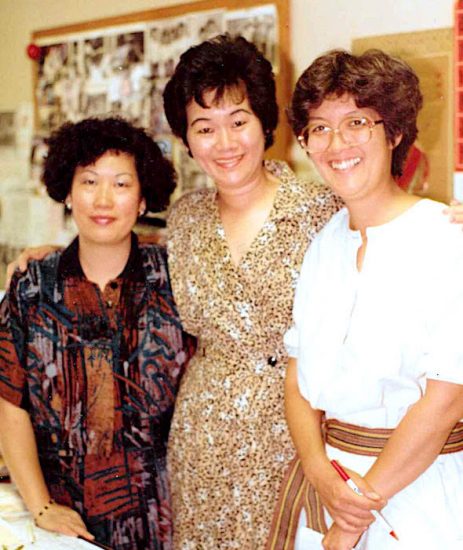Changed U.S. Labor History
Women workers and organizers remember staging the massive 1982 Garment Strike in Chinatown
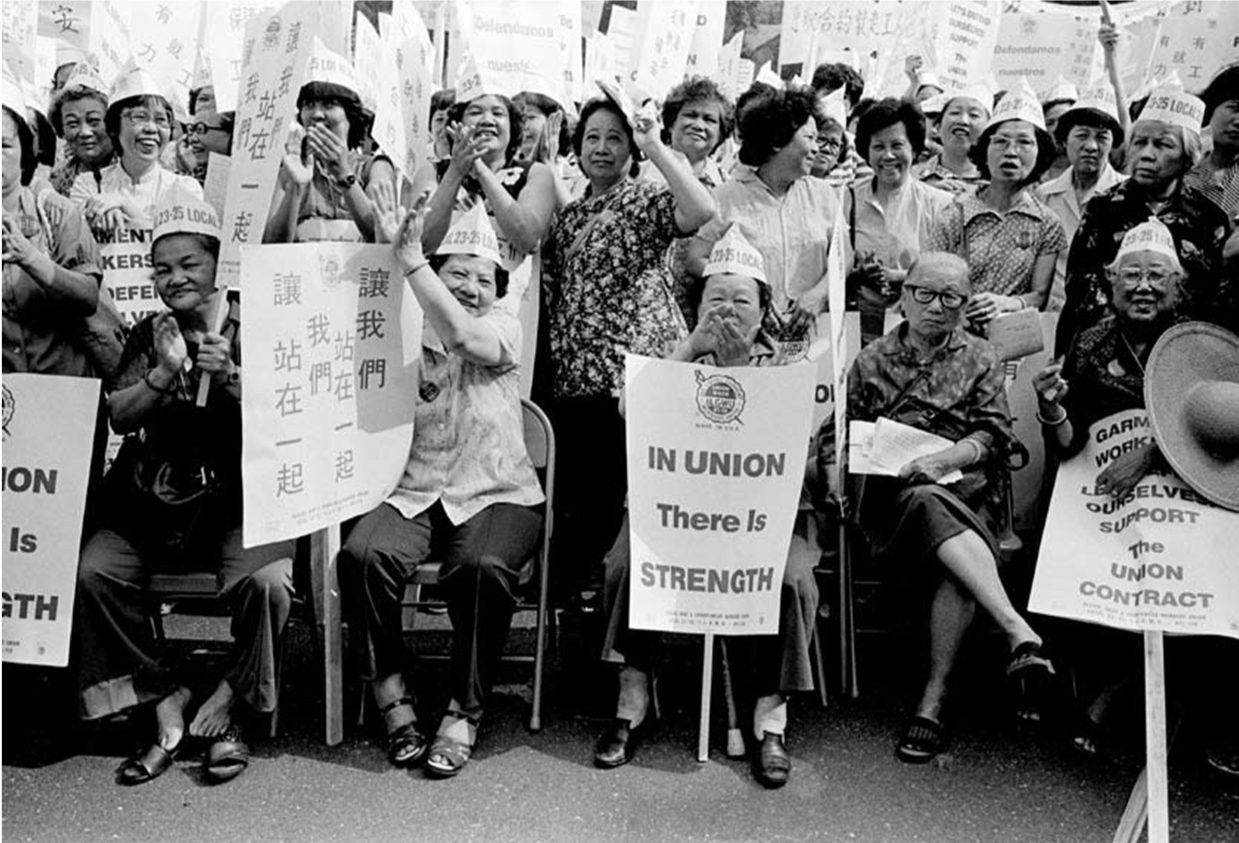
May 1, 2019
Beyond dim sum restaurants and new bubble tea and dessert cafes, historic sites of resistance line Chinatown’s streets.
On Mott Street, over 20,000 garment workers—almost entirely women—once marched down the center of Chinatown to Columbus Park on a warm Spring day in 1982. They donned union hats and raised picket signs to press for the renewal of their union contracts. United, immigrant Chinese American women called for workers’ rights that would forever impact U.S. labor history.
In fiery speeches that were met with enthusiastic applause and cheers, women leaders exposed the plight of working women, and extolled the Chinatown community to carry on with the struggle for better wages and better working conditions.
Within hours, dozens of garment shop owners called the union, finally agreeing to renew the workers’ contracts. That day, Chinese women won a historic victory in labor rights, securing wage increases and benefits for tens of thousands women workers in the city.
I first saw the black and white photo of elderly immigrant Asian women a decade ago when I was in high school. I was just beginning to be exposed to Asian American history in afterschool youth programs. A friend had shared it on Facebook. My initial reaction: shock—I had never seen or heard about protest being something grandmothers in my community participated in; and then curiosity—what was this moment in Chinatown’s history and why had no one told me about it before?

One brisk Fall afternoon, I meet May Chen in the lobby of her long-time friend and co-organizer Connie Ling’s apartment building. Carrying a chocolate cake from Tous Les Jours Bakery, May leads me upstairs to meet Connie and Alice Ip, another core organizer of the 1982 strike. Our meeting day happens to be Connie’s birthday.
“It’s small but it’s been my home for many years,” Connie says, seating us in her living room and offering us coffee and oranges. May lays out baked goods.
These three women are Chinatown OGs—core organizers of the International Ladies’ Garment Workers’ Union’s (ILGWU), that led the 1982 Uprising. The strike lives vividly in their memories and though retired from their union work today, they tell of those times with the tenacity and spirit as if it had happened yesterday.
“My mother-in-law’s job was to cut the thread. Mine was to sew the garments,” Connie said, convivially.
“She got a needle pricked in her finger once and she had a bandage that was like a big ice cream,” May chimed in, laughing.
“The work was really hard for me,” Connie chuckled. “Like so many other women, I didn’t have any experience sewing clothes.”
“We did it for our livelihoods,” Alice added in Cantonese. “The garment shops were in such a high demand for workers that they gave us the opportunity to learn. So even if your hands shook and you were scared, you had to do it.”
“The machines were so fast,” May added.
“I’ve been pricked countless times,” Alice said.
Connie arrived in New York after national quotas were eliminated with the passage of the Immigration Act of 1965. Traveling with her family who fled the political turmoil in their home province in Mindanao in the Philippines, she arrived in New York City in 1967 and began to work in a garment shop three weeks later.
Nine years later, Alice immigrated to the U.S. in 1976 and began working in a garment shop her second day in New York City.
May, born and raised in Boston, came to ILGWU from years of prior labor organizing work and education activism. Unlike Alice and Connie, she was the first generation born in the U.S. and became politicized during the civil rights movement and student strikes in the 60s. After years of union organizing and teaching Asian American Studies in California, she moved to New York City in 1979 and joined the ILGWU after the strike in the 80s. She would become the legal assistant and educational director of the union, involved in Chinatown’s activism for the next decades. It was in the union that she met Connie and Alice.
Connie is the tallest of the three women, short brown hair tinted with highlights. She speaks enthusiastically. May sits next to her, hair tied up in a ponytail, voice firm and gentle. Alice, chair at the end, dons dark auburn hair, soft red lipstick, and speaks reflectively.
“The good bundles that were easy to make were called ‘sih yauh gai, soy sauce chicken’—they were the styles quicker to make and learn, that could earn you more money,” Connie said, switching between English and Cantonese. “At first, I thought they were talking about a dish.”
The laughter of the three women rose to the plant-lined sunlit windows to their left. “You’d say ‘sew a soy sauce chicken.’ When the styles were changed and it was hard to make, we’d call it ‘zyu gwat, pork bone'” Alice continued. Pork bones were too difficult to eat.
Alice and Connie worked in garment factories in New York City at a time when immigration revitalized the garment industry. Jobs were available for anyone who wanted to work then and required no need for English fluency. By the late 1970s, Connie’s third year in the U.S., four in 10 Chinese families had members working in the garment industry.
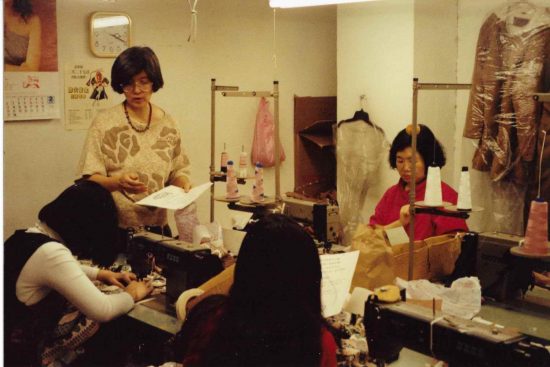
By 1980, four years after Alice arrived, there were 25,000 Chinese garment workers employed in 430 shops. Women made up over 80 percent of the workforce. This period was a new experience for many Chinese women, 85 percent of whom were married; they were allowed, for the first time, to leave homes en masse and earn a living.
“Before there were garment factories, women didn’t have that much work,” May said. “They had to sit in the apartment and look out the window all day because their husbands won’t allow them to go outside. So when the factories opened, they were so happy. Since the workplace was all women, some of the husbands said ‘okay, you can go out and earn a little money.'”
Canal Street hosted a heavy concentration of garment shops. Conditions varied. Overcrowding was common and buildings were often old and neglected. The shops presented hazardous conditions for workers, including inducing tuberculosis from poor ventilation and kidney and gastric problems from dehydration and long hours working under stress.
Women had to deal with over 10-hour workdays and they were paid by piece. The $3.35 minimum wage was often ignored and instead, workers were paid based on the number of clothing that they made and style-sewed; for skirts and jackets, for instance, the workers were paid 50 cents a piece. The more pieces they sewed, the more they earned. According to the union during that time, garment workers on average earned $5,500 annually in reported wages in 1981, after accounting for seasonal and part-time work.
In 1982, Connie and Alice were hired as business agents to represent the workers of unionized garment factories to handle negotiations and grievances. At the time, more and more shops were unionizing because of the mutual benefits between shop owners and workers. Their main role was to act as the liaisons between the union and management, and represent the interests of the workers. As women, the positions were not easy for them.
“I went to garment factories and was advocating for workers to have holiday pay. One owner, who was part of a gang, pulled a gun on me,” Alice said, sitting across from me. Her voice was loud and clear. She waved her finger as she continued to describe that day in the 80s when she almost met death in a Chinatown garment factory.

“And I wasn’t afraid. I said to him, ‘Do you know who I am? You’re the owner, of course I know who you are. But do you know who I am?’ He wanted to scare me, so I pretended I wasn’t afraid.”
Her conviction that day rang loud to her storytelling today, over 30 years later. During that time, she regularly visited the workers in many of the garment shops, like many other union representatives and organizers.
“I said to him, ‘You’re trying to harass me now. I gave up everything to work this job. God decides if I live or die. I don’t care. If you want to kill me now, come on.”
At the last words, she switched from Cantonese to English with a delivery reminiscent of the men protagonists in action movies before opening fire.
“Then he hurriedly stowed away his gun and told his boys to hurry up and bring me some coffee. He then said, ‘if there’s a problem, let’s talk about it.'”
As Alice finished her story, next to her, May and Connie burst out laughing. Those moments were now long past that they could be met with humor.
That same year, contractors refused to agree to terms that were already agreed upon by the manufacturers and the union. Instead, they threatened to take away holidays and other benefits. Workers were furious and resistance in everyday conversations filled the subways, grocery stores and homes. Threat of a strike became a greater reality. Workers soon joined together, speaking on radio stations, phone banking, handing out leaflets in the streets to organize and mobilize fellow workers to join the strike.
The day of the strike finally came on June 24.
“On the day of the strike, some women were so afraid of participating that they hid in the bathrooms of the shops,” Connie said. “We had to go door-to-door, opening the bathroom door to get them to join.”
Over 20,000 mostly women workers participated in the strike that day. They filled the streets and marched down Mott Street to Columbus Park. There were so many people that the crowd poured onto Canal Street two streets away. Union officials and workers delivered impassioned speeches that fired up the crowd.

“The Chinatown bosses’ attempt to break our union is like a grasshopper trying to stop a car in its tracks. They are daydreaming in broad daylight and acting like a blind bat trying to knock down a tree,” Shui Mak Ka’s voice boomed at the podium. A garment worker and core organizer of the 1982 Strike, she addressed thousands.
I met Shui Mak Ka one Sunday afternoon shortly after I sat down with Connie, Alice and May. Upon learning that I am doing a story on the Uprising, another Chinatown OG Karen Low immediately insisted I had to also speak with Shui Mak, whom she calls Mrs. Ka. Karen was a member of I Wor Kuen, a Marxist-Leninist Asian American collective formed in 1969 in Chinatown, inspired by the Black Panthers and Young Lords.
Mrs. Ka speaks Cantonese and Karen helps interpret union words I do not understand. Although I speak Cantonese, union and strike vocabulary words were ones I never learned before. In our interview, Mrs. Ka speaks loudly and with an impassioned fierceness.
“Take a picture of this shirt,” Mrs. Ka, who is nearing her 90s, says, holding up the white ILGWU T-shirt she keeps on her armchair in her midtown apartment.
Her living room is filled with stacks of photo albums, magazines, and t-shirts. Her son and filmmaker Shing Ka is sitting on the couch adjacent to me after gently placing a pot of green tea between Karen and I.
“They gave me a stack of papers to read from at the podium. And I said ‘waste of time.’ What did I say? Quite simply, we workers must be united. It’s not yet spring, unless all flowers blossom. We cannot rely on a single worker’s power, but we need all the workers together,” she says. Her speech at the protest march quoted lines from Mao Zedong, former Chairman of the Communist Party of China.
Following the speeches, the workers marched—a Chinese dragon, union banners, drums and cymbals in tow. Once the rally began, the union’s office received endless calls from employers finally conceding and agreeing to sign the contracts. By late afternoon, all but one shop had signed the contract.
“We must dig the man out of the hole,” Mrs. Ka said at the time, referring to the last boss. “I said to them, ‘Brothers and sisters, who knows the owner of this shop, on 22 Bayard Street, 4th floor? Who knows this boss?’ There was a woman, who patted her heart, and said ‘Mrs. Ka, I know him! I know where he goes to eat lunch. I’ll go find him.'”
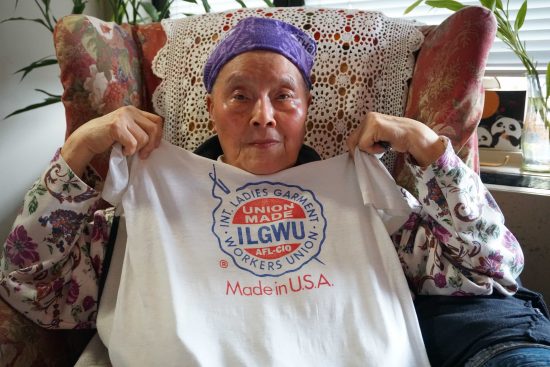
Mrs. Ka gestured to her own heart, imitating the woman decades ago. “She found him and we demanded that he sign the last contract. We forced him and he signed all of it.”
I was sitting across from her in her living room, jaw-dropping at her fighting spirit for the livelihoods of her peers at all costs. Karen translated for me my next question, “What inspired you to keep going no matter how hard things got?”
Mrs. Ka began explaining her sense of justice since her childhood. Her son, Shing, answered in English, quietly as she spoke, “She was born that way. Her character is like that. It’s the way she was born.”
After the Uprising, the ILGWU became more active in the Chinatown community in supporting Chinese members and addressing the social issues affecting the community. The strike in itself also made it known that Chinese women workers organized actively for their rights and would not let ethnic ties with Chinese employers stifle their fight for economic justice.
As a result, employers held back on wage cuts and withdrew their demand to take away holidays and key benefits. The strike paved the way for increased bilingual staff for workers, English classes and transportation services.
“The community really saw the strength of mobilization,” May said. “That’s why the next year after, there was the fight against the jail.”
Months later, the city moved to build a jail in the heart of Chinatown. In addition to behind-the-scenes meetings and organizing efforts, 12,000 people marched from Chinatown to City Hall to protest the city’s plan. The jail was still eventually built, with the city government saying it needed its location there because of its proximity to the courts, a similar argument made for the expansion of the current jail in Chinatown under Mayor de Blasio’s plan to close Rikers. The community then compromised to gain back a piece of the land next to the jail, which became the Chung Pak building that housed a senior residence, day care, and health center.
Members of the ILGWU, including May Chen, meanwhile, went on the co-found the Asian Pacific American Labor Alliance, the first national organization for Asian Pacific American union members. All of the women joined ILGWU staff and continued to be involved in the labor movement.
“The next generation needs to learn how to organize. Know that other people’s issues are your own. If you don’t organize, you too will lose all of your benefits,” Mrs. Ka added.
Today, the garment industry is almost nonexistent in Chinatown, after 9/11 and after labor was outsourced to other countries. Chinatown continues to change, with the neighborhood facing rapid gentrification and thousands of residents displaced. What remains true is that, like in 1982, Chinatown community members continue to organize.
The 1982 Strike is a testimony to the immigrant women’s strong sense of social justice and resolve to organize and fight for meaningful and lasting change. Although it seems that the 1982 Strike has been fading from public memory, it is part and parcel of the rich history of Manhattan’s Chinatown that should never be forgotten.
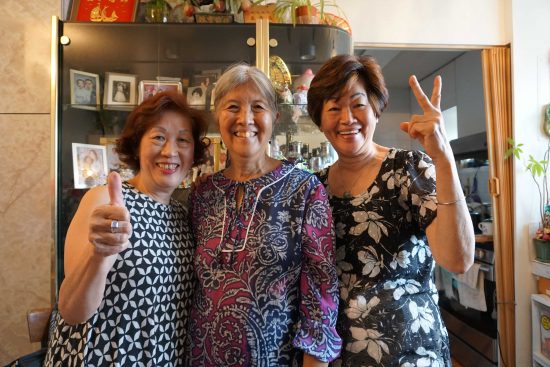
Listen to Shui Mak Ka discuss the 1982 Garment Strike.

